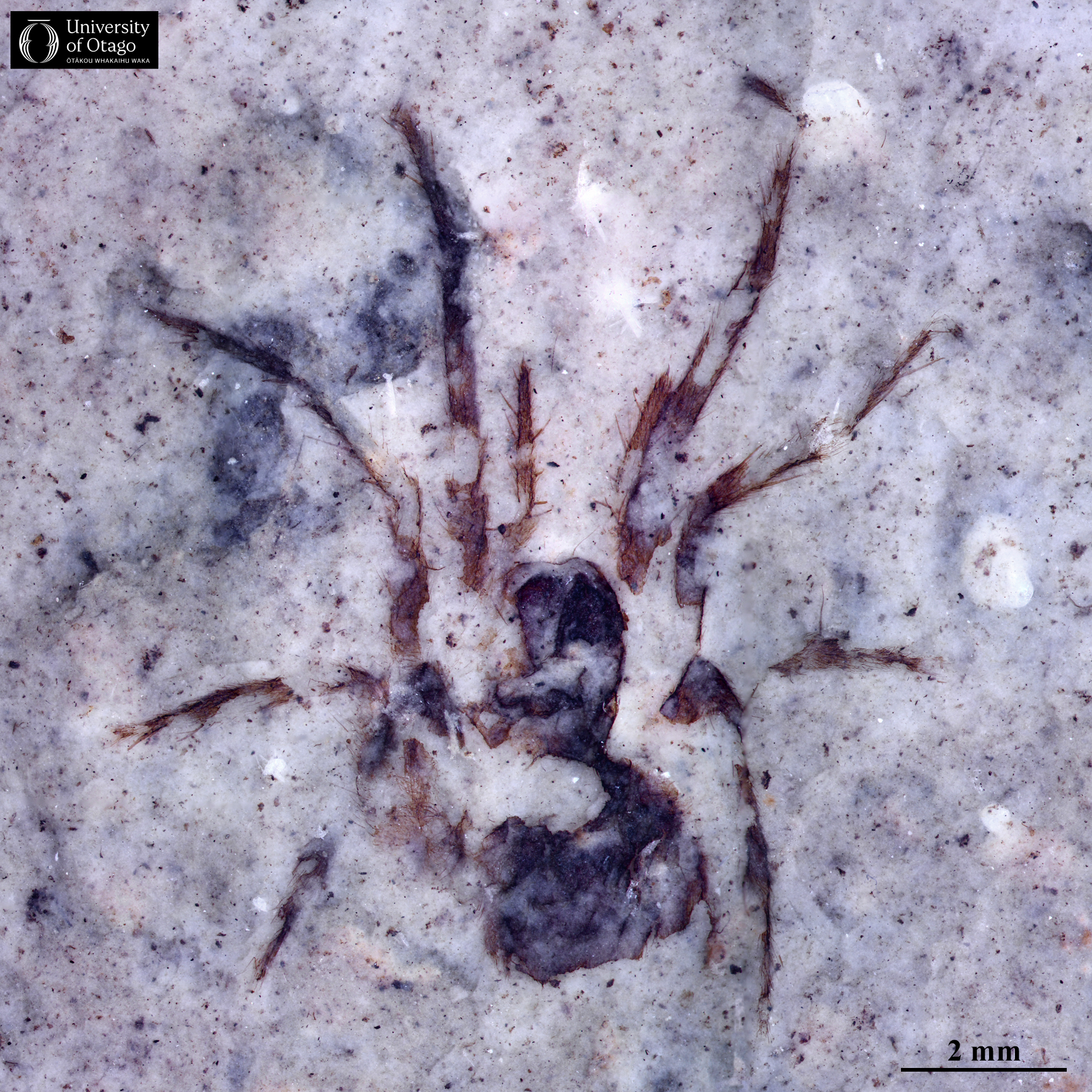49 Juvenile armoured trapdoor spider
Arthropoda, Arachnida
Spiders are usually the top invertebrate predators in forest ecosystems in Aotearoa New Zealand. All produce silk for their webs (although not all spiders have webs) and to aid travel, and all use venom to subdue their prey.

This small juvenile armoured trapdoor spider (OU 45208) may have been washed out of its burrow near the shoreline into the Foulden Maar lake during heavy rain. Image credit: U Kaulfuss. |
New Zealand today has more than 1600 known endemic species of spider placed in 137 genera or subgenera, in 57 different families.
Spiders are rare as fossils, having no hard parts to be preserved. And, until 2018, no spider fossils were known from New Zealand. But that year, two important research papers based on newly discovered fossils housed in the University of Otago Geology Museum collections allowed the first glimpses of New Zealand fossil spiders. The first was an overview of discoveries in New Zealand amber mainly from Harliwich’s Coalmine, near Roxburgh. Here arachnid remains include several well-preserved, though undeterminable juvenile spiders which appear to represent web-builders, rather than free-living hunters. Well-preserved spider web filaments also occur with trapped insect remains, fecal pellets, fungi and stellate plant hairs. These spiders lived in an ancient kauri forest and were trapped in sticky resin that has now become amber.
But, more important were four spiders discovered by Uwe Kaulfuss in the Foulden Maar diatomite. Two of these had their original spider cuticle replaced by or covered over by pyrite. These pyritised specimens could not be given species names as important details of their anatomy cannot be seen but one is likely to be a male orb weaver spider.
The other two specimens belong to the Mygalomorphae, a group of powerful predators with robust bodies, stout legs and strong jaws with fangs that inject venom into their prey. One specimen in particular is especially well-preserved and is identified as a juvenile armoured trapdoor spider (family Idiopidae).
—Written by Daphne E Lee and Uwe Kaulfuss
| Specimen number: OU 45208 | Age: 23 million years old (early Miocene, Waitakian stage) |
| Locality: Middlemarch, Otago | Rock Formation: Foulden Hills Diatomite |
| Collected by: U Kaulfuss | |
| Citation: Selden PA, Kaulfuss U. 2018. Fossil arachnids from the earliest Miocene Foulden Maar Fossil-Lagerstätte, New Zealand. Alcheringa: An Australasian Journal of Palaeontology 43:165–169. doi.org/10.1080/03115518.2018.1450446 | |
Any animal that is not a vertebrate (i.e. does not have a backbone). Examples include sponges, molluscs and echinoderms.
Evidence of life from a past geological age. Remains like bones, shells or wood, or an impression like a footprint, or some other evidence of life, from something that was alive more than 11,700 years ago.
A former crater lake with abundant diatoms, and now a fossil site known for diatomite and famous for high-quality fossil preservation. Located near Middlemarch in Otago, New Zealand. See: Fossil Treasures of Foulden Maar.
Sedimentary rock composed of the frustules (shells) of diatoms, a type of algae.
An iron sulphide mineral, FeS2. Commonly known as "Fool's gold".

